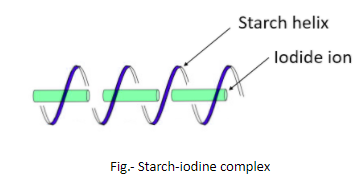
Name the chemical used to test starch.
Answer
494.4k+ views
Hint: The chemical belongs to the group of halogens and is a non-metallic solid with a purple-black luster in the standard conditions but it melts to form a deep violet liquid when the temperature is around 144 degrees celsius.
Complete answer:
Iodine is used to test the presence of starch and this test is known as Starch-Iodine test. In this test, the presence of starch is detected by observing a change in color that is due to the formation of a complex. The reagents in this test are – a solution of $I_{2}$ (iodine) and KI (potassium iodide). The solution of these two chemicals in water is generally light orange-brown but when it is added to another solution or sample that contains starch, the light orange-brown color changes to deep blue. This change in color is due to the charge-transfer complexes. In the presence of potassium iodide, the iodine forms polyiodide ions like $I_{3}^{-}$ that act as charge donors and get embedded in the amylose helix forming a complex that is deep blue.

So, it is clear now that it is the amylose in the starch which is responsible for the formation of deep blue color by forming a complex with iodine. Iodine is a lustrous purple-black non-metallic solid belonging to the group of halogens.
Note: There is a limitation of this test that it cannot be performed in a very low pH environment because in such conditions, the hydrolysis of starch occurs and it prevents the formation of a starch-iodine complex that gives the blue color as an indication of the presence of starch.
Complete answer:
Iodine is used to test the presence of starch and this test is known as Starch-Iodine test. In this test, the presence of starch is detected by observing a change in color that is due to the formation of a complex. The reagents in this test are – a solution of $I_{2}$ (iodine) and KI (potassium iodide). The solution of these two chemicals in water is generally light orange-brown but when it is added to another solution or sample that contains starch, the light orange-brown color changes to deep blue. This change in color is due to the charge-transfer complexes. In the presence of potassium iodide, the iodine forms polyiodide ions like $I_{3}^{-}$ that act as charge donors and get embedded in the amylose helix forming a complex that is deep blue.

So, it is clear now that it is the amylose in the starch which is responsible for the formation of deep blue color by forming a complex with iodine. Iodine is a lustrous purple-black non-metallic solid belonging to the group of halogens.
Note: There is a limitation of this test that it cannot be performed in a very low pH environment because in such conditions, the hydrolysis of starch occurs and it prevents the formation of a starch-iodine complex that gives the blue color as an indication of the presence of starch.
Recently Updated Pages
The correct geometry and hybridization for XeF4 are class 11 chemistry CBSE

Water softening by Clarks process uses ACalcium bicarbonate class 11 chemistry CBSE

With reference to graphite and diamond which of the class 11 chemistry CBSE

A certain household has consumed 250 units of energy class 11 physics CBSE

The lightest metal known is A beryllium B lithium C class 11 chemistry CBSE

What is the formula mass of the iodine molecule class 11 chemistry CBSE

Trending doubts
Arrange Water ethanol and phenol in increasing order class 11 chemistry CBSE

A mixture of o nitrophenol and p nitrophenol can be class 11 chemistry CBSE

Every party in India has to register itself with A class 11 social science CBSE

Describe the effects of the Second World War class 11 social science CBSE

What type of battery is a lead storage battery Write class 11 chemistry CBSE

Which of the following methods is suitable for preventing class 11 chemistry CBSE




